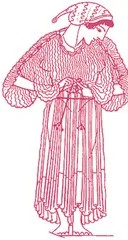Prehistoric and Ancient Clothing史前和古代的服饰
作者: 卢屹/译

What did prehistoric people wear?
史前人类穿什么?
It is not known for sure when humans began wearing clothes but there is evidence that suggest that we may have begun wearing clothing as far back as 100,000 to 500,000 years ago. Archeologists found objects that look like handmade sewing needles that have been dated to around 40,000 years ago. The first needles that we are sure that are needles belonged to the Solutrean culture which existed in France from 19,000 BC to 15,000 BC. Evidence of dyed flax fibers dates back to 36,000 BC and was found in a prehistoric cave in the Republic of Georgia. The first evidence of weaving was found in Dolni Vestonice in the Czech Republic in the form of impressions of textiles and basketry and nets on pieces of clay and is 27,000 years old. Venus figurines1, from some 25,000 years ago, from Western Europe are decorated with basket hats or caps, belts and a strap of cloth. Venus figurines from Eastern Europe wore belts and string skirts. Net gauges, spindle needles and weaving sticks are also found by archeologists and are believed that they were also used in the making of textiles.
人类开始穿衣服的确切时间不得而知,但有证据表明,我们可能早在50万到10万年前就开始穿衣服了。考古学家发现了约4万年前貌似缝衣针的手工制品。首批确定无疑的缝衣针属于公元前1.9万到1.5万年前存在于现今法国的梭鲁特文化。染色亚麻纤维的证据可追溯到公元前3.6万年,发现于格鲁吉亚共和国的一个史前洞穴。编织的最早证据发现于捷克共和国的下韦斯特尼采,是陶土片上留下的形似织物、筐、网等的印痕,已有2.7万年的历史。大约2.5万年前西欧的维纳斯雕像装饰有筐形帽或无边帽、腰带以及一根布带。东欧的维纳斯雕像则扎腰带、穿绳裙。考古学家还发现了织网用的尺板、锭子针、编织棒,认为它们也是用于编织的工具。
The first known humans to make clothes were Neanderthals who, at some point in history, learned how to use the hides of the animals they hunted to keep themselves warm and dry. There is also the possibility that first clothes had primarily other purposes such as magic, decoration, cult or prestige, and were later found to be practical as well. Cro-Magnon man, who came after Neanderthal, improved clothes by using sharp awls, pointed tools and needles made out of slivers of animal bone with a point at one end and an eye at the other. He punched small holes in hides and then simply laced them with sinew and other types of cordage that could be found in nature. One of the first simpler clothes was tunic2 which was made from two pieces of rectangular animal hide laced together on one side with a hole left for the head in the middle. Arms went through the open sides and the tunic was closed with a belt.
已知最早制作衣服的人类是尼安德特人,他们在历史上的某个时期学会了使用猎物的皮毛让自己保持温暖干燥。最初的衣服原本可能另有他用,比如巫术、装饰、崇拜、权威等,后来被发现也有实用功能。尼安德特人之后的克罗马农人改进了衣服,用的是锋利的锥子、尖锐的工具、用兽骨条制成的一头尖而另一头带孔的骨针。他们在兽皮上打小孔,然后直接用动物肌腱组织或者自然中现成的线状物进行缝制。最早的一种简易衣服是把两片矩形兽皮的一边缝起来、中间为头部留出空隙的上衣。手臂从两侧开口伸出,衣服用腰带束紧。
The best example of a complete set of prehistoric clothes is that found on Ötzi the Iceman found in the Alps in 1991, which is 5300 years old. His clothing and equipment were made from hides, bones, antlers and feathers of six different animal species and the leaves, wood and fiber of 17 different trees. His upper clothing was tied with a belt. His legs were covered with two separate leather stocking-like leggings which were made of several pieces of goat hide and attached to his belt. Shoes that he had were made of animal skins like brown bear hide, deer leather and calf leather and filled with hay. Coat that he wore was made of strips of goat skin that were sewed on the inside with thread made of animal sinews. On his head was 20cm tall hat made of bear fur which had leather chin straps. Cape that was on his back was made of long stalks grass.
一套完整史前衣服的最佳例证是1991年在阿尔卑斯山发现的冰人奥茨身上的衣服,有5300年的历史。他的衣服和装备是用六种动物的皮、骨、角、羽毛和17种树的叶、木、纤维制成的。他的上衣扎了腰带,两腿各穿了一条长筒袜似的绑腿,绑腿是用几片山羊皮做成的,并系在腰带上。他穿的鞋是用类似棕熊皮、鹿皮和小牛皮的兽皮做成的,里面填了干草。他穿的外套是用动物肌腱组织做的线将一条条山羊皮从内侧缝制而成。他头上戴了一顶20厘米高的熊皮帽,还有皮制的下巴束带。他背上的斗篷是用长草秆做的。
Clothing in the ancient world
古代世界的服饰
Types of clothing used in the ancient world depended on the technologies that were invented in that time. We have evidence about what people wore then from depictions of people in the art of the time and from archeological findings of fabric fibers and leathers that are sometimes very well-preserved. The first actual textile was probably felt. Nålebinding was also another early textile technique and it dates from 6500 BC.
古代世界使用的服饰种类取决于当时的技术发明。关于古人穿什么的证据来自当时艺术作品中的人物描绘,也来自织物纤维和皮革等考古发现,它们有时被保存得相当完好。最早的真正织物可能是毛毡。单针环织法是另一种早期编织技术,可追溯到公元前6500年。
Earliest woven textiles of the Near East may be fabrics dated to c. 6000 BC. They were used for wrapping the dead and are found at a Neolithic site at Çatalhöyük in Anatolia. Flax was cultivated from c. 8000 BC and breeding of sheep with a wooly fleece from 3000 BC.
近东地区最早的梭织品可能是大约公元前6000年的织物。它们用于包裹尸体,发现于安纳托利亚加泰土丘的一个新石器时代遗址。亚麻种植始自公元前8000年左右,长毛绵羊养殖则始自公元前3000年。
In Ancient India, cotton was used as material for clothing from 5000 BC.
古印度从公元前5000年开始就把棉花用作衣服材料。
In Ancient Egypt most of the textile was made out of flax. Wool was known, but was used rarely (only for coats that were for instance forbidden in temples and sanctuaries) because it was considered impure as animal fibers were considered taboo. Complex clothing was reserved for higher classes while lower class wore only the loincloth or schenti. Both women and men wore same shoes—sandals braided with leather or, if they were bureaucrats and priests, braided with papyrus. They also wore tunics, robes, short-sleeved shirts, pleated skirts. Women also wore draped dresses made of white or unbleached fabric.